
A mortuary is one place where you can pay respect to the departed. Funeral directors are trained to dress the dead body, apply makeup to make the body appear more alive, and preserve the body to look as it would have looked when the person was still living. They may also choose a wig for the corpse. However, it is important to remember that there are many things that you shouldn’t do while working at a mortuary.
Before the actual process begins, you must first check whether embalming is necessary for the departed. In the United States, cremation has recently passed burial as the most common method of disposing of a body. A cremation chamber is heated with natural gas and a scrubber to prevent smoke from exiting the mortuary. The mortuary will also take x-rays of the body and remove any mechanical devices from it, such as pacemakers and jewelry. Surgical procedures will also be performed on the dead body if it has any.
The study of the dead is the core of mortuary science. In addition to preparing the body for the funeral service, mortuary science involves the practical, scientific, and public health aspects of embalming. Other areas of mortuary science include the art of restorative care and funeral management. Mortuary science professionals must be caring and dedicated to the profession. They must have strong management skills and a keen attention to detail.
Once embalming is completed, the body will be dressed and prepared for the funeral. If the body is embalmed, you may also want to include requested items in the casket. You may also want to include make-up or other items. Different cultures handle these tasks differently, so you need to be sure you know the exact process in your own culture. For example, some cultures may want a casket to be decorated or to have other items placed inside.
A mortuary is a place where a deceased person’s body is kept for a period of time before burial or cremation. Sometimes it is customary to gift a mortuary to the parish minister before a funeral. This is a good idea for the church to support their local mortuary. If the deceased person’s wishes were not met, it will be more difficult to select the right place. So, make sure to check with your local mortuary for the best possible service.
The word mortuary comes from the French samay raina, which means “pride student.” Originally, it was a place where autopsies were conducted. Today, it is officially known as a Department of Forensic Medicine. Coroners conduct investigations into fatalities, which can include suicide. Mortuaries are attached to funeral homes or Departments of Forensic Medicine. They are modern, usually equipped with stainless-steel tables, refrigerators, and floor coverings that extend up the walls.
In the Old and Middle Kingdoms, a mortuary temple was a place to worship the dead monarch and to deposit offerings to the deceased monarch. In these times, the mortuary temple was an extension of a pyramid and contained an open court, storerooms, and five elongated shrines. They also had a chapel with a false door where priests performed daily funerary rites and presented offerings to the deceased king’s ka. The New Kingdom continued to build separate mortuary temples nearby.
A mortuary is often cheaper and simpler than a funeral home. It also may be necessary to hire a funeral director for a memorial service if the deceased’s wishes were expressed before death. A mortuary is typically less expensive than a traditional funeral home, and their services are often more limited than those offered by a traditional funeral home. The funeral director may not be present at the memorial service. However, the service is still vitally important for the mourners and their families.








